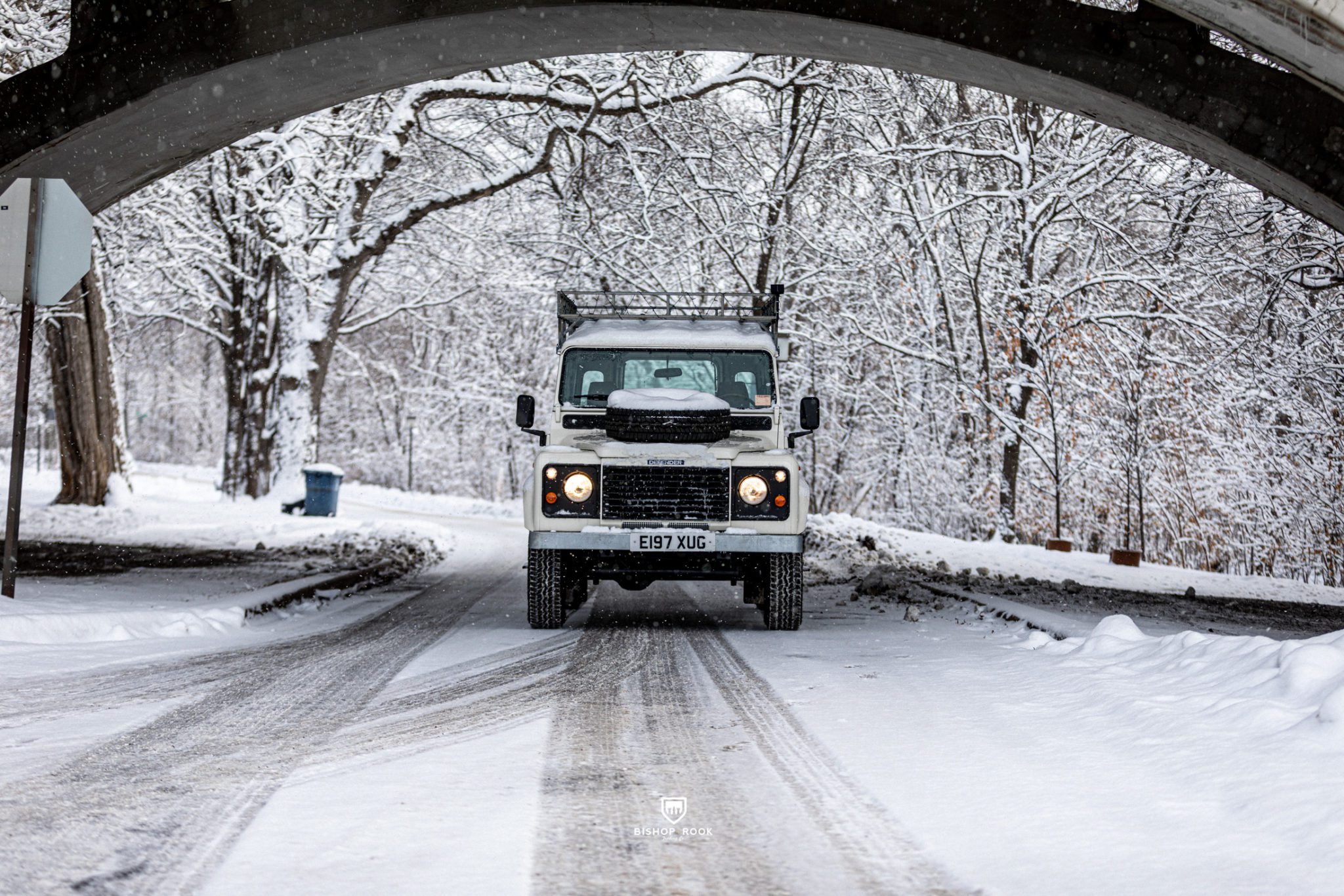After years of working exclusively on Land Rover Defenders, we started to see the same issues show up on nearly every vehicle that came through our workshop doors. We compiled our list here and made it part of our “Mechanical Certified” Bishop+Rook Defender Program.
There are three categories of Defenders we service in our workshops:
- Donor/Base vehicles we’ve sourced and purchased for customer builds
- Customer vehicles they’ve adopted from us, or another builder
- Customers who bought a Defender sight-unseen and come to us to rescue them
For the first category we generally know what we’re getting into – as we typically look at 100 different Defenders before we select one that’s a good candidate for restoration or preservation. We gather as much history as we can from the previous owners, MOT testing documentation, and pretty much look over every aspect of the vehicle. If we’re doing a full restoration we’re looking for major issues that will take valuable shop time – with little benefit to the final build. There’s nothing we can’t fix or replace, so we’re not that concerned with neglected maintenance or a little rust/corrosion here and there. After all, we make a living fixing these issues. For the general owner, this isn’t always the case – maintenance issues can distract from your Defender enjoyment, which makes us sad.
The Hidden Mechanical Nightmares
We see some particularly interesting mechanical gremlins show up from shops that have focused more on cosmetics and less on actual reliability. There are several dealers/traders around the world (and the US) that have a very poor reputation of selling Defenders that are in sad mechanical condition and will cost a captain’s wages to bring them up to a reasonable standard. We’ve even had a few of these unscrupulous sellers try to use us to do the “bare minimum” of repairs to a vehicle to make it look good to sell. We always turn those folks away.
Things we’ve seen from internet sellers claiming “well sorted vehicle” or “recent restoration undertaken”:
- Freshly painted silver exhausts – over rust holes (actual holes)
- Freshly sealed chassis with the mud BEHIND the sealant (ensuring moisture is trapped)
- Brake pads that were literally metal on metal
- Painted over silicone hiding massive rust holes
- Brand new center cross members hiding 6 inch rust holes on each side
- Bondo used to patch a rusty cross member before painting
- Electrical – all kinds of bad and unsafe wiring issues
- 15 year old dry-rotted tyres
- Radiators and intercoolers with zero functional fins
- The list goes on
The same cautionary tales can be true of parts vendors as much as Defender traders. For example, the below image is from a 300Tdi Auto Repower Package we bought from TerrainTech Parts in the UK. They claimed it was a fully serviced engine and ready to go. They lied.

Not-So-Serviced Water Pump from TerrainTech Parts
What a Baseline Mechanical Refresh Should Include
With any 25+ year old vehicle, there are going to be parts that are worn out, broken, or simply need updating. Waiting for one of these items to leave you stranded on a day trip or vacation is a nightmare in waiting. For any new build, no matter the level of restoration, we’ve developed what we internally call a “Tier I” mechanical refresh. It covers all the major wear items on a vehicle and ensures that the Defenders we send out into the wild will be just as reliable as when they left the factory assembly line (or pretty close to it).
Items That Always Need Repair, Replacement, or Upgraded
This is a list of items we come across that always need attention, so we now make it standard on any vehicle that leaves our shop. A lot of these items are infinitely more cost effective to address at the same time, instead of one issue at a time.
Wheels + Tyres – Most budget defenders will have mismatched or weather cracked tyres that are well beyond their safe use.
Battery – Most Defenders will be coming from a completely different climate than many parts of the US. If it’s over a year old, we replace it.
Bearings and Seals – We don’t mind a little puddle of oil and grease on the floor, we don’t like the idea of a seized bearing or a pitted swivel housing. They get replaced.
Steering Box – With a great degree of confidence, we can say that 99% of steering boxes will leave a puddle under your Defender on the first day, unless the lower seals are replaced or the whole box is rebuilt.
Brakes + Rotors – All of our builds include a full brake service – pads, rotors, calipers, soft lines, etc.
Electrical + Lights – After 25 years of bush fixes, you’re bound to end up with some twisted and taped wires, not to mention the corroded Lucas connectors. Even though it is a tedious job, we go through everything.
Cooling + Intercooler – We simply replace the radiator and intercooler rather than hoping for the best. Keeping your Defender temps down is the key to long-term wear and tear.
Seatbelts + Safety – We check all safety systems to make sure it’s up to our standards – if not, they get replaced.
Clutch – Clutch master and slave both get replaced with new.
Timing Belt – If we don’t have maintenance records on a vehicle we crack the timing belt cover open and replace it with new for peace of mind.
Water Pump – Must like the radiator, the water pump and thermostat are key to keeping your engine in tip-top shape Going from limited use on the English countryside to American motorways can put a lot of pressure on a cooling system – best to make sure it’s fully serviced.
Fuel Delivery – From the lifter pump and fuel filter, these can all leave you stranded or simply smoking up the neighborhood each morning with restricted fuel delivery issues. We replace both, including testing and refurbishing injectors, seals, and fuel lines, as needed.
Air Filters – ti’s a simple thing, but it’s important to keep fresh air pumping into your Defender engine.
Starter – The starter is in a terrible location to fix without the motor out of the vehicle. We take care of that so you don’t have it.
Alternator – These are prone to failure after years of use in varied climates. Like the starter above, it’s nice nice to know this won’t let you down.
Annual Maintenance Costs + Concerns
Most modern cars can run for 100,000 miles without any major issues. After that point its usually age that takes the toll on the systems of the vehicle – especially corrosion on electrical components. The same holds true for classic Defenders – especially diesel engines. As long as you perform some basic annual maintenance you shouldn’t have to worry about anything catastrophic happening. We advice people to plan to spend around $500-$1500 a year, depending on use and climate.
Here are the basic issues you should check and maintain each year:
- Oil Change – every 3,000 to 5,000 miles, with frequent checks on long road trips or heavy use.
- Fuel Filter Monitoring – Change out if you suspect poor quality diesel or live in a climate that has summer/winter blends.
- Periodic check of clamps and hoses – ensure they are snug and properly tightened.
- Check tyres for improper wear – making sure your Defender is aligned and tyres are properly inflated will prolong the life of your tyres and improve safety and fuel mileage.
- Battery – connections can come loose due to vibration, so a quick snug up will provide extra security.
- Enjoy – the best way to make sure your Defender is in tip-top shape is to drive it and enjoy it.
What Did We Miss
If you have further questions or comments, we welcome feedback.












You must be logged in to post a comment.